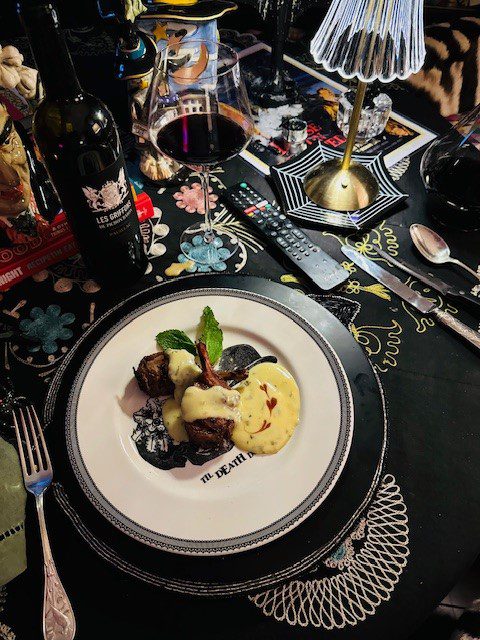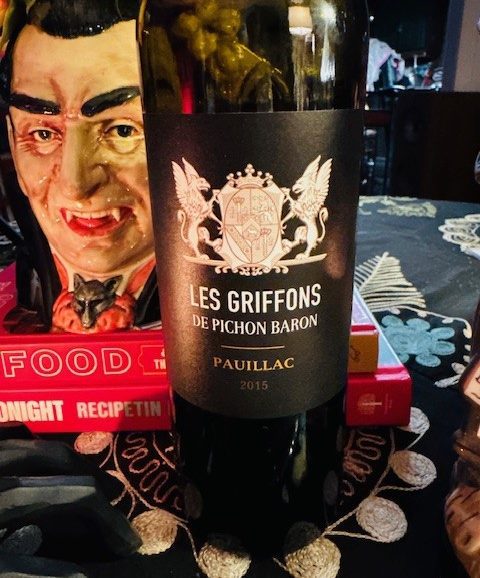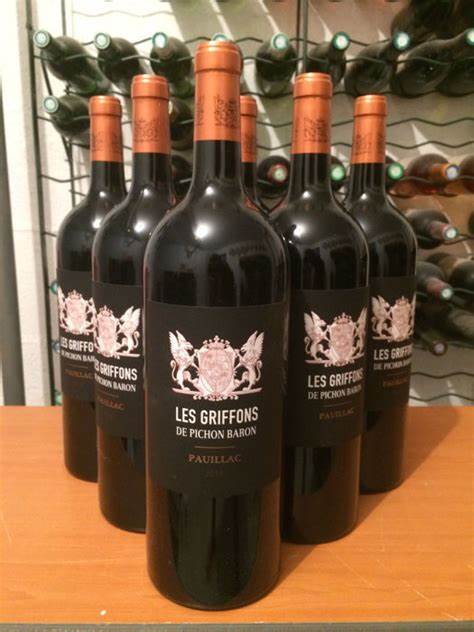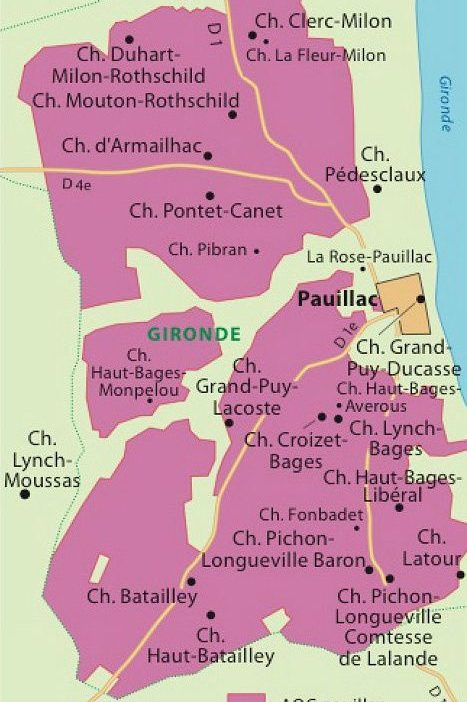

A critic named Jeff Leve said: Made from a vat selection before the blending of Pichon Baron, this wine offers supple tannins, fresh cassis, blackberries and plums. It is softly textured with a purity of fruit much improved over previous vintages. Even though the blend is dominated by Cabernet Sauvignon, this wine will be enjoyable on release or it could also age for a few years. 89-91
Jeb Dunnock said : The second wine of the estate (of which there are two) first made in 2012, the 2015 Les Griffons De Pichon Baron sports a deep ruby/purple color as well as a medium to full-bodied, concentrated, yet sumptuous style that’s so common in this great vintage. Black fruits, graphite, lead pencil, tons of gravelly minerality (almost Graves-like), and smoky meaty notes all emerge from this ripe, polished, more than a little impressive Pauillac that’s going to shine for upwards of 20 years.
Clearly, Mr. Dunnock knows more about wine than I do! And he wrote his review in 2017. I drank this wine in October of 2024, and I have to say, I did NOT find it to be “sumptuous.” I tasted SOUR cherry and, yes, I did get the smoky meat notes. But the wine didn’t give off as much fruit as I like in a Cab and I thought the mouth drying effect was a bit overdone. Now, when I read the Wikipedia notes, I learned that a wine like this is a quintessential Bordeaux, and is described as “stark.” Maybe I just don’t love this style of wine as much as I like a big fruit bomb, and maybe that says something about my unsophisticated palate. All I know is that I drank this wine much more slowly than I usually drink a red wine, and found myself holding it in my mouth a long time before swallowing it. It just wasn’t a carefree easy drinking wine. This wine was MUCH better when I was drinking it with lamb chops and a Bearnaise sauce which offset the tannins. That’s when it really started singing. I’m not saying this wasn’t a good wine — it was balanced and elegant. It just didn’t pack the punch I expected from a bottle that cost me around $80.00.
Maybe this is a good time to comment on what I think of as my own “terroir of mood.” Terroir is the character of a wine that is imparted to it by the place in which it is produced. But there’s also a taste that is imparted to a wine by the mood or state of mind the consumer is in! When I think of certain wines that I love (e.g. Chateau Gloria, Dunn cabernets) I remember where I was, who I was with, what I was eating and how I was feeling when I drank the wine. Those subjective factors play a huge role in how a wine is perceived. So, maybe with this wine I was just expecting something else and while the wine was polished and beautiful, it wasn’t the accompaniment I was seeking on a Saturday night when I was watching, “The Birds,” for about the 50th time, and hoping for a big cinematic “knock my socks off” experience. This might have knocked someone else’s socks off last night, and it might knock mine off on a different night. The guy at Dorignac’s who recommended it thought it was “drinking great” right now. I dunno. That’s what makes the world go ’round, right?
ACCORDING TO WIKIPEDIA: Pauillac ([po.jak]) is a wine growing commune (municipality) and appellation d’origine contrôlée within Haut-Médoc in Bordeaux, centred on the small town of Pauillac. Hugh Johnson has said, “If one had to single out one commune of Bordeaux to head the list, there would be no argument. It would be Pauillac.”. Pauillac includes three of the five premier cru châteaux of Bordeaux: Latour, Lafite Rothschild and Mouton Rothschild. The wines of Pauillac are often considered the quintessence of Bordeaux wines.
Pauillac is on the west bank of the Gironde, generally known as the “Left Bank”. St-Julien is to the south. A stream called Ruisseau de Juillac marks part of the boundary between the two communes; other parts are marked by a stone wall and a country lane. To the north, across the Jalle du Breuil, lies St-Estèphe. Pauillac is bounded on the west by the parish of St Sauveur and the Landes forest. All three communes lie within the Haut-Médoc. The town of Pauillac is the largest in the Médoc, with a population of over 5,000. Pauillac is somewhat more elevated than the surrounding area, rising to a peak of nearly 30 metres above sea-level in the region of Château Pontet-Canet. The soil is gravelly, as with most of the Haut-Médoc. The forest to the west shelters the vines from the Atlantic winds. Pauillac contains around 1,200 hectares of vineyards.
Cabernet Sauvignon is the predominant grape, but it is invariably blended with other grapes. As with all red Bordeaux, Merlot, Cabernet Franc, Petit Verdot, Malbec and Carménère may also be included in the blend (although wines will not necessarily include all six grapes). Prior to the 19th century, Malbec was predominant.
The style has been described as “stark”. The predominant fruit flavour is usually blackcurrant, sometimes veering into plum. Pencil-shavings and cigar-box are also characteristic notes.
Wine from Pauillac may be labelled as Haut-Médoc (usually wine which the château considers inferior to its main offering and wishes to market under a different label). Similarly, second (or third) wines from the grandes châteaux may be labelled simply as Pauillac
Wine Information
2015 CHATEAUX PICHON-LONGUEVILLE LES GRIFFONS DE PICHON BARON
Brand: Chateau Pichon-Longueville
Wine Type
Bordeaux





